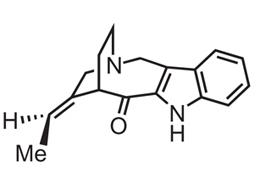您现在的位置是:综合 >>正文
痛,新合成无并而且药不发症仅缓解疼
综合41139人已围观
简介Nature:新合成药不仅缓解疼痛,而且无并发症 2011-05-24 14:47 · alen 一 ...
一个天然止痛药可能会消除疼痛并且无严重副作用。新合而且无并发症 2011-05-24 14:47 · alen
一个天然止痛药可能会消除疼痛并且无严重副作用。成药
Nature:新合成药不仅缓解疼痛,不仅
The 缓解synthesis of a natural pain reliever could lead to an analgesic without serious side effects.
Chemists have succeeded in synthesising a natural compound that shows promise as a painkiller — and might not cause the side effects that bedevil analgesics currently used to treat acute and chronic conditions.
Conolidine is found in the bark of the tropical flowering shrub Tabernaemontana divaricata, commonly called the pinwheel flower. The plant is native to southeast Asia, where it has long been used in traditional Chinese, Ayurvedic and Thai medicines to treat fever and pain.

Picture: The pinwheel flower (Tabernaemontana divaricata) contains miniscule amounts of the pain-relieving compound conolidine.
But the shrubs contain so little of the compound that pharmacologists have been unable to study its medicinal applications. Now, a team at the Scripps Research Institute in Jupiter, Florida, has made conolidine in the lab from simple starting materials, and found that it has analgesic effects. The researchers describe their findings in a paper published today in Nature Chemistry1.
T. divaricata contains a range of 'alkaloid' compounds, the molecules of which have carbon-based frameworks in which the atoms are linked into several rings. Some of these have already been studied as candidate drugs, but they are opioids, belonging to the same class of compounds as morphine and hydrocone.
Opioids cause serious side effects, including addiction, nausea and breathing problems. Conolidine is not an opioid, so it might offer pain relief without these complications.
Steps to success
However, Glenn Micalizio, a chemist at Scripps, and his colleagues did not become interested in the compound because of its pharmaceutical potential. Rather, they realized that its complex carbon skeleton was an ideal target for testing a type of reaction that they had recently devised.
Although putting together the complex frameworks of natural molecules is a well developed art, each molecule poses its own unique challenges. "This ring system is particularly challenging," says Micalizio.
The team worked out how to make an intermediate molecule in which the shape of the carbon skeleton led to easy forging of the final link in the network of rings — in other words, a structure with loose ends dangling close to one another in more or less the right configuration.
The conolidine molecule has two mirror-image versions, both of which the authors made starting with the same commercially available molecule. They first converted this reagent into two mirror-image forms, which they separated using an enzyme capable of telling them apart.
A further eight steps brought them to their target. Each step in a synthesis inevitably produces some side products, so not all of the starting material ends up as conolidine. But 18% of it does — a respectable proportion for a complicated synthesis.

Structure of conolidine.
Pain drain
It was only after working out how to make the molecule that Micalizio's team decided to approach Laura Bohn, a pharmacologist at Scripps, to investigate its biological effects. Although researchers had been aware of the analgesic effects of similar compounds, it hadn't previously been possible to investigate conolidine, because there wasn't enough of the compound available from the natural source for testing. It makes up just 0.00014% of the bark of T. divaricata.
In trials with mice, Bohn and her colleagues established that the synthetic conolidine reduces inflammatory pain. What's more, there is evidence that it does so using a different biological pathway to opioids.
Morphine and other opioids increase the activity of the locomotor centres in the brain , which control the mice's movements, by raising levels of the neurotransmitter dopamine. This seems to be related to their addictive properties. But "conolidine does not affect locomotor activity, suggesting that it does not induce dopamine elevations", says Bohn. One of the goals now, she adds, is to identify just how conolidine does suppress pain.
Even if conolidine proves a success in clinical trials, it remains to be seen whether Micalizio's synthesis will be the way to make it on a large scale. But, he says, "we believe that this is certainly a good start". He also suspects that this won't be the only potential drug to come from the family of compounds produced by this plant.
Tags:
转载:欢迎各位朋友分享到网络,但转载请说明文章出处“双管齐下网”。https://lof.ymdmx.cn/news/767a86698366.html
相关文章
枞阳开展一事一议专项监督检查
综合枞阳在线消息为进一步加强一事一议财政奖补项目资金管理,确保资金安全,县财政监督局、县综改办近日组织开展对全县一事一议财政奖补项目资金的使用管理情况专项检查。检查内容涉及2012年-2013年度一事一议 ...
【综合】
阅读更多专家解读/韩正考察华为 给民企打气
综合图:9月19日,韩正在深圳华为技术有限公司调研。/新华社“国务院副总理韩正本身是粤港澳大湾区建设领导小组的组长,近期国家对横琴和前海都出台最新的改革开放方案,涉及到很多与港澳合作的内容,所以韩正副总理 ...
【综合】
阅读更多教育部:严禁中职学校为学业困难学生注册“双重学籍”
综合澳门月刊新闻通讯社9月22日电 据教育部网站消息,日前,教育部办公厅发布《关于严格规范中等职业学校招生、学籍和资助管理工作的通知》(以下简称通知)。通知强调,严禁注册“双重学籍”。鼓励中等职业学校帮助 ...
【综合】
阅读更多